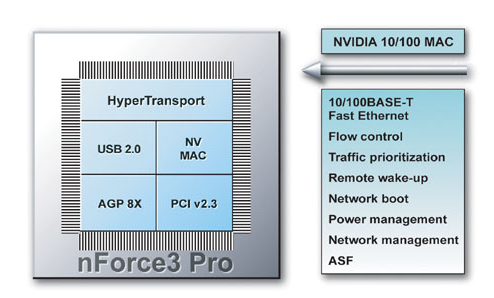NVIDIA's nForce3 150
Try as we might, we couldn't find a block diagram of NVIDIA's all-new nForce3 150 chipset. However, there's many floating around that illustrate the nForce3 Pro's architecture. It seems as if NVIDIA's Pro and non-Pro chipsets are one and the same; the Pro nomenclature being attributed to the Opteron 1xx and 2xx CPUs, as well as the Athlon 64 FX range. The non-Pro caters for the Clawhammer-based CPUs.

Ignoring the Pro labelling above, we see that the nForce3 150 is a single-chip architecture, that is, it has no definable North or South Bridge. The traditional two-chip model dictates that the memory controller and AGP accesses are resident on the North Bridge whilst high-speed connectivity, storage interfaces, PCI conduits and a host of other hardware-related activities are located on the South Bridge. As AMD has chosen to implement an on-die memory controller for the Clawhammer, NVIDIA decided that a single-chip solution would suffice. The rationale lay in, they say, lower latencies and a super-fast link to the CPU, which is the standard Athlon 64 HyperTransport bus.
VIA still chooses a 533MB/s link between its K8T800 and VT8237 bridges, NVIDIA's 0.15-micron manufacturing eliminates that bottleneck altogether. What we must remember is that VIA's North Bridge to CPU link runs at a blistering 6.4GB/s - that's full speed. NVIDIA's own literature is confusing and contradictory. Initial information sheets put the nForce3 150's Hypertransport link at an identical 6.4GB/s, via an 800MHz (double-pumped to 1.6GHz) link with a 16-bit wide bus. It now appears that NVIDIA has revised its bus speed, and is now quoting a total bandwidth of 3.6B/s (1.2GB/s towards the CPU - 600MHz with an 8-bit bus width, and 2.4GHz from the CPU - 600MHz with a standard 16-bit bus width). That's plenty enough for the moment, but we do hope that NVIDIA manage to inch it up to the full 6.4GB/s, as per VIA and specification.
New to the nForce 3 150 is the use of 3 ATA133 controllers. Three's an odd number - literally. What NVIDIA plans for is on-chip IDE RAID that's capable of RAID0, RAID1 and RAID0+1. It also plans to introduce a new set of drivers, under the name of ForceWare, that implement RAID functionality. Further, it transpires that one can add a couple of SATA bridges off the third ATA133 controller, much in the same method Marvell currently apply its SATA technology. The upcoming ForceWare drivers will also add a piece of software that's close to many an enthusiast's heart - a comprehensive OS-based system-monitoring application that'll allow the user to change almost every conceivable parameter from the cozy confines of an OS desktop. NVIDIA's StreamThru network management software will also be a key part of the ForceWare set. A standard 6 PCI 32-bit 33MHz slots will be catered for, as well as 6 USB2.0 ports and an AC'97 v2.1 interface. On-board sound for the masses. Forgive our lack of enthusiasm.
It appears as if something had to give in NVIDIA's push for a single-chip design. Out goes the DualNet, FireWire, and the lovely APU (Audio Processing Unit). That was one of the nForce / nForce2's chief charms. We're kind of baffled by its exclusion. If anything, there was hope that a 24-bit / 96KHz hardware-accelerated APU on the nForce3. The nForce3 will now rely on the host CPU to do the donkey work in assisting on-board sound. There's no SATA support, either. It will have to run via discrete controller, most likely from Silicon Image. NVIDIA states that 'select' versions of the MCP3 will showcase on-chip Gigabit LAN and RAIDable SATA, all in a single-chip design. If truth be told, we expected those to be present right from the off. The features of the nForce3 150 aren't as clear cut as VIA's. We'll have to wait and see what partners come up with. Apart from the single-chip design that seems to hamper features, the nForce3 is more of a sideways and even backwards step rather than an advancement over the incumbent nForce2. More is the pity, really, as one of the nForce2's selling points was a veritable features count that left the PCI slots free for other uses. It was perfect for a mini-ATX design.









